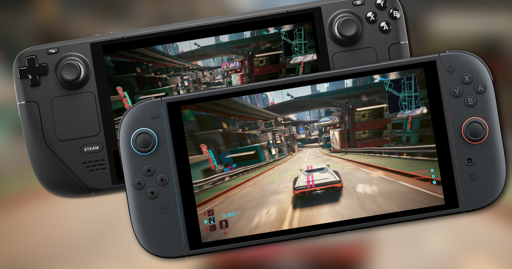- cross-posted to:
- pcgaming@lemmy.ca
- cross-posted to:
- pcgaming@lemmy.ca
For someone owning both devices and actually trying to decide which version to get, both are decent in portable mode with the Switch 2 taking the lead in docked mode (as the Deck doesn’t increase its power limits in docked mode whatsoever). So I’d probably get the Switch 2 version if I didn’t have a desktop PC to go with my Deck, but I do, so my “docked” experience (playing on my PC) is vastly superior anyway, with the Deck getting the portable part done.
For a technical comparison it’s kind of inaccurate I think. Yes, it’s certainly impressive that the Switch 2 can run this game in portable mode likely consuming less than 10 watts for the entire system while producing okay graphics. And it’s clear that DLSS does a lot of heavy lifting here, but:
- The 8.9 watts figure is likely somewhat inaccurate because it’s based on approximate battery life while playing the game. Even if the game is played from 100% to 0%, there’s still inaccuracies because the specific battery likely won’t have 19.3 Wh exactly. Instead it’ll likely be a bit higher than that when brand new, and a bit lower with 100s of cycles.
- The Switch 2 clearly consumes less power than the Deck needs to achieve “playable” framerates in Cyberpunk 2077, but that doesn’t tell us that much about the efficiency of just the SoC. I’d assume the Deck requires a little bit more juice for its OLED screen and also more for the rest of the system, for example the standard NVMe drive it uses. The “approximately 9 watts consumption” comparison they’re doing makes it look like the Switch 2 is around 3 times as efficient, but that’s not how efficiency curves work. You’re comparing the Deck at a power consumption level that’s probably the peak of Switch 2s efficiency curve.
- Game settings are (currently?) impossible to match. Some can be matched, others are either some in-between on Switch or even “lower than low”, for example some models/geometry. I assume these changes have a large enough performance impact that CDPR thought they were worth to implement just for the Switch 2.
- Scene-specific pixel counting wasn’t really done, so it’s not possible to say which device renders more “real” pixels (even though DLSS certainly seems to make the most out of these pixels).
I still think the Switch 2 is very impressive in terms of performance in portable mode, certainly more than I expected when hearing about the rumored Ampere architecture and the Samsung manufacturing process.
It also shows that something comparable to DLSS (likely FSR 4) would be hugely beneficial to PC handhelds so I hope that the Deck 2 will properly support that. Sad that AMDs Z2 series don’t, but I hope Valve is cooking another custom chip with AMD soon.
on steam at the moment, Cyberpunk is 20.99.
Switch 2 version is 69.99
👋thanks for trying nintendo.
Or for me it would make CP2077 and hundreds of other games free to play on the Steam deck (since I already own them)
You can buy it on a cartridge for Switch and later resell it.
If you know where to look, a certain athletic woman can give it to you for free if you’re on a Steam Deck!
Do you know how to use said athletic woman’s installers on the Steam Deck, or Linux in general?
I don’t know where to look. Please help
!piracy@lemmy.dbzer0.com is a good start on the sidebar
Or you could reward CDPR for maintaining support and releasing a wonderful DLC for it with a purchase on a platform that lets you own your games (and is incidentally owned by CDPR too)
While I agree that one should support developers of games they enjoy if they are able, I recently tried another playthrough of this game and it reminded me how unpolished it is.
Things like
- Quest NPCs taking very robot-like paths while walking (walk straight for 10 steps, turn right 90 degrees instantly, walk straight 5 steps…) instead of something more natural
- Needing to wait 5 minutes for an NPC to get to a specific spot and/or complete actions before being able to continue conversation. Typically on the fight missions, you’d win the fight, they’d take 30 s to get up, then saunter over (using an unnatural path) to the designated spot, which then took another 10 seconds to activate the speech option finally.
- Pedestrians diving into the road in front of your car instead of away.
Perhaps games like GTA spoiled us, but I just found these too annoying to continue.
Wii fit trainer?
Nah it’s amélie poulain
Now that’s one fit girl.
She even gets it done in Smash.
Nintendo aren’t the ones who set the price
At least e.g. steam can’t arbitrarily choose to brick your colputer
Does Nintendo let you play content that you accidentally downloaded from the high seas? And do you need to worry about Nintendo killing your account for doing such a thing?
Well, at least for the physical edition, they have to account for the cost of the 64 GB game card they are using. Wasn’t that rumored to cost like $16 a piece?
I highly doubt it costs that much. You can buy 64GB SD cards for ~$10 retail, which includes:
- margin for retailer
- margin for company “making” it
- margin for factory producing it
If each step is something like 50% markup (not unheard of), the cost to actually get these things from a factory is probably about $2. Make it a bit more expensive because the packaging is unique to Nintendo, and their quantities are probably a bit less than regular retail SD cards, so maybe it’s like $5 per card.
That’s a lot more than an optical disk, which are probably under $1, but nothing too crazy.
I have no special insight here, just some general understanding of how retail works.
There isn’t official pricing nor reliable sources out there so I’m going by rumors.
With your calculation you have to keep in mind that the Switch 2 cards have to somewhat match microSD Express speeds, so a more accurate comparison would be these, but they aren’t available in 64 GB sizes.
All I’ve heard is that they’re expensive and with the larger sizes often required for Switch 2 games it’s an even bigger problem than with Switch (1). These key cards exist for a reason. And I’d bet Nintendo takes a margin on these instead of only requiring the publisher to cover the manufacturing costs.
In theory it makes sense but in the past buying digitally as opposed to physically hasn’t netted anyone any savings. And with the new system where the card doesn’t even hold the actual game, it’s an even worse offering.
Buying on PC is a lot cheaper than buying on consoles typically, especially after a year or two, and PC sales are mostly (all?) digital now.
And the thing about cartridges not holding the game is limited to specific games, devs still have the option of putting the full game on a cartridge instead of the license option. All that happened here is that devs got another option on how to sell their game, so if you want to gift someone a digital game but want a physical item to give to them, the license on cartridge option is perfect, and AFAIK it preserves the ability to resell the game (may be dependent on the game though).
Cyberpunk is on a 64 GB card that holds the entire game.
My point is that Nintendo does play a big factor in the price choice.
no, they don’t. but the game has been out for 5 years at this point.
articles like these seem quite pointless to anyone who doesn’t already own a switch 2. and possibly pointless even to people who own a switch 2, but have already played cyberpunk on better or similar hardware.
this article is an attempt to pat a multi billion dollar company on the back so it doesn’t feel as bad that people aren’t racing out to buy their 5-year-late, overpriced attempts to dominate the handheld market again.
Possibly the dumbest take I’ve ever seen on this site, are you saying an article objectively comparing the performance of two handhelds is “an attempt to pat a multi billion dollar company on the back”?
articles like these seem quite pointless to anyone who doesn’t already own a switch 2.
“Performance comparisons are pointless if the results aren’t what I like”, I’m sure if the steam deck performed a lot better you would be in the comments singing praises for it. Digital foundry have been comparing performance for many years but suddenly now their findings are worthless.
Yeah they’d never shill for Nintendo and fail to disclose it was an ad https://m.youtube.com/watch?v=V10wHzV5zp0
They disclosed it many times and have talked about that video often, it doesn’t affect their content. I didn’t like it either but acting like they’re not trustworthy because of one time they were sponsored is dumb
They’re literally selling faster than the original Switch, what the fuck are you smoking?
Does anyone notice much difference between 25 fps and 30 fps at these screen sizes?
I don’t have one these handhelds, but in general, I’ve found that smaller screens make lower frame rates feel a lot less choppy.
The difference being 25 v. 30 is the murky side of DF here.
The game runs at 40fps on Switch2 in handheld and in docked with a 120hz display. DF chose to lock it to a 60hz display so the game would lock back to 30.
It’s disingenuous.
Why would a smaller screen make framerate not matter? Textures and resolution, sure, but framerate always matters.
Because the distance (and the angle subtended within your field of vision) traveled by a moving object from one frame to the next is shorter.
The shorter the distance, the more it looks like smooth movement vs. sudden jumping.
Yes but frame rate is primarily about responsiveness, not aesthetics, which is why AI frame generation is a horseshit idea.
Yes but frame rate is primarily about responsiveness, not aesthetics,
In games that tie physics and inputs to frame rate, 25-30 fps is about a 30-40 millisecond response in the worst case; usually less. That’s plenty fast enough in most games I’ve played. And not all games do that anyway. So I can’t say I agree with your statement as a general rule.
What game do you play where that’s not fast enough?
In any case, it’s irrelevant to my point. The comment you responded to is explicitly about the frame rates feeling choppy. Meaning visual effect.
You also said “feel” not “look”. If you exclusively meant aesthetics you should clarify it in your own comment.
Also, responsiveness is not about if something is “fast enough” it’s about making the thought>action gap as small as possible for better immersion and player control. Higher FPS means there is a more consistent time from input to effect. If i press a button in a 30 fps game the input delay can be anything from almost none to 1/30th of a second (30ms, which if you played online games back in the day is not great), and there is no way to tell how much it will be. The more frames the less of a possible variance you experience.
Also all input is tied to framerate, if you have examples of games that have their input loop completely separate from framerate I’m all ears, especially given rendering is not on demand.
You also said “feel” not “look”.
I did, in order to express that I was thinking of overall sense conveyed by the visuals, rather than whether differences in frame rate could be noticed under scrutiny. Words often have multiple meanings depending on context.
you should clarify it in your own comment.
I could, but I won’t, since I’m not interested in indulging combative misinterpretations of what I wrote, and nobody else seems to have had trouble understanding me. Bye bye.
Inability to learn from your mistakes is nothing to be proud of. Delete this













